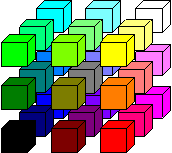Exploring an idea
from PERCEPTION to MAGIC
|
|
Abstract it!
Good mathematicians
do it a lot.
Theoretical
physicists often make a point of it.
.
|
Solipsism, egocentrism, enthocentrism,
anthropocentrism.... These are pretty good descriptions of
attitudes of a human being maturing from infancy toward...
...whatever.
|
What
is "color"?
And what is colorblindness?
|
PERCEPTION
|
IMAGINATION
|
METAPHOR
|
MATHEMATICS
|
MAGIC
|
|
primitive
|
a few other critters
|
only humans
|
a stretch for us
|
beyond
comprehension
|
|
We see what we see.
|
We imagine what we might
see.
|
We see patterns in how
we might arrange colors, and so we assign names.
|
We discover patterns
within the patterns: we see abstractions
|
We might somehow sense
that there is much we do not see. It is very, very much.
|
 We see a world of color.
We see a world of color.
|
 |
 3
Munsell parameters:
3
Munsell parameters:
Hue
- Sat. - Lum.
3
families of screen-dots:
Red
- Green - Blue
3
CIE parameters:
X
- Y - Z
|
CIE diagram
(a nomograph)

Feynman's
depiction of the protanope's 2-D projection from the 3-D of normal human
color. |

Birds
and insects see color  we
have (almost) no way to think about. we
have (almost) no way to think about. |
It seems to everyone
that what we see is just what's there.
In about 1685, Isaac
Newton discovered realms of vision beyond human vision.
....
|
ULTRAVIOLET
|
VISIBLE
|
INFRARED
|
|
Since Newton, science
has discovered much, much more that lies beyond human perception.
(Many
other animals have known about some of this for millions of years.)

Light is a bit like waves
on water.
Those water waves are a
few feet apart.
Light wave lengths are measured
in millionths of a millimeter.
.......
Far
violet:
400
millionths
|
.......
|
Far red:
700
millionths
|
|
ULTRAVIOLET
INFRARED
Our eyes are blind
to the rest:
............
| COSMIC
RAYS |
X-RAYS
|
UV
|
VISIBLE
|
IR
|
RADIO
|
VLF
|
|
| MILLIONTHS OF MILLIONTHS |
MILLIONS
OF METERS
|
|
Then,
just what is color?
It's Mother Nature's
attempt to give us perception of wave-length
distribution of
light!
at
least of that tiny bit of the spectrum that we can see.
The light that gets to our
eyes is almost never of just one wavelength.
It's a whole range of wavelengths,
with more of some and less of others.


This is a graph of the wave-length
distribution of light that might be reaching our eyes just after sunset.
That spike in the yellow
is a bit of light from a sodium-vapor street light.
The sharp cutoff
in the ultraviolet is due to a number of atmospheric effects;
for example, Rayleigh scattering
(the scattering of light that makes the sky blue and
the sunsets
red) and chemical absorption, especially by that of ozone...(cont.)
Of course,
we see none of this.
Because our eyes aren't
spectroscopes.
Mother
Nature didn't do a very good job when she designed our color vision.
Our
color vision is a good first step, though (birds did
better). Here's how it works:
At the back of our eyes (on
the retina) are three different kinds
of bright-light sensors,
very, very small and very, very many.
Each kind of these "cones"
samples a bit of the spectrum.
One
kind is most sensitive to light of about 450 millionths of a meter.
One
kind is most sensitive tol ight of about 550 millionths of a meter.
One
kind is most sensitive to light of about 580 millionths of a meter.
(But
it also has ehanced sensitivity to light of about 430.)

kind
So when some light enters our eyes, those three kinds of cones take
a first step toward constructing that graph. A complete graph needs
a point for every wavelength that we can see. Our cones give us just
three points. Those three points are not points on the graph, but are
only raw material for our brains to work with to inform us of a little bit
of the information that would be given us if our eyes were spectroscopes.
The mathematics
level of abstraction
can help us ask and answer
questions where our vision fails us.
What
about
Colorblindness?
 normal
normal
|
 protanopic
protanopic
|
 totally
colorblind
totally
colorblind
|
|
All
three cones
functioning
|
Blue
and green cones
functioning.
|
Blue
cones only functioning
|
| Colors
order in three dimensions |
Colors
order in two dimensions |
Colors
order in one dimension. |
Color blindness can
be of many other kinds.
For example; deuteranopia
is blue and red
cones functioning.
 |
 |
 |
| When
normal human color vision sees this . . . |
...protanopic
vision sees this |
and
blue-cone only vision sees this. |
What
does a bird (with 4, 5, or 6, components of color
vision) see?
We
have no way of seeing that with our eyes.
What
does a bee (with polarization vision) see?
We
have (almost)
no way of seeing that with our eyes.
In
our solipsisms,
our egocentrism,
our enthocentrism,
our anthropocentrism,
(or whatever)
we tend to be blind to so much
of our world.
and so
even our more erudite teachers
might miss the meanings
of;
FOR
EXAMPLE
RETURN
to From Perception to Magic





 we
have (almost) no way to think about.
we
have (almost) no way to think about.







